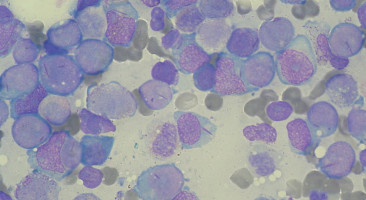
by ecancer reporter Janet Fricker
Researchers have identified two distinct patterns of therapy resistance cells in acute myeloid leukaemia (AML) already present at diagnosis that explain relapse, reported a study in Nature.
The Canadian investigators tracked the evolutionary history of AML within individual patients from diagnosis to relapse.
Long term survival is poor in AML, as most patients relapse despite obtaining remission.
Historically, therapy failure has been attributed to mutations that produce drug resistance, possibly as a consequence of the mutagenic properties of chemotherapy.
However, other lines of evidence have suggested resistant cells are generated by evolutionary processes prior to treatment and then selected by therapy.
In the current study, John Dick and colleagues, from University of Toronto, Canada, used a biobank to obtain mononuclear blood samples from 11 AML patients.
Using paired diagnosis/ relapse samples, the team undertook combined genetic and functional analysis of purified subpopulations and xenografts.
They identified two major patterns of relapse.
In some cases, relapse originated from rare leukaemia stem cells with a haematopoietic stem/progenitor cell phenotype (relapse origin-primitive, ROp).
In other cases, stem cells developed from larger subclones of immunophenotyically committed leukaemia cells retaining strong stemness transcriptional signatures (relapse origin-committed, ROc).
The findings, suggest the authors, have implications for both cancer biology in general and the way AML is monitored and treated.
“The presence of genetically diverse LSCs (leukaemia stem cells) at diagnosis highlights a major limitation of therapies that target only the specific properties of the dominant clone,” write the authors.
Deployment of new methods of disease monitoring combining genetic and cellular analysis, they add, could lead to improved clinical trials in which the drug response of genetically diverse LSC subclones are tracked.
“Accordingly, therapeutic strategies must not only eradicate bulk tumour cells but also effectively target cancer stem cells,” they write.
Additionally, the authors add, given their different biology ROp versus ROc AML cases will require different therapies.
Reference
Shlush L, Mitchell A, Heisler L, et al. Tracing the origins of relapse in acute myeloid leukaemia to stem cells. Nature. 10.1038/nature22993
We are an independent charity and are not backed by a large company or society. We raise every penny ourselves to improve the standards of cancer care through education. You can help us continue our work to address inequalities in cancer care by making a donation.
Any donation, however small, contributes directly towards the costs of creating and sharing free oncology education.
Together we can get better outcomes for patients by tackling global inequalities in access to the results of cancer research.
Thank you for your support.